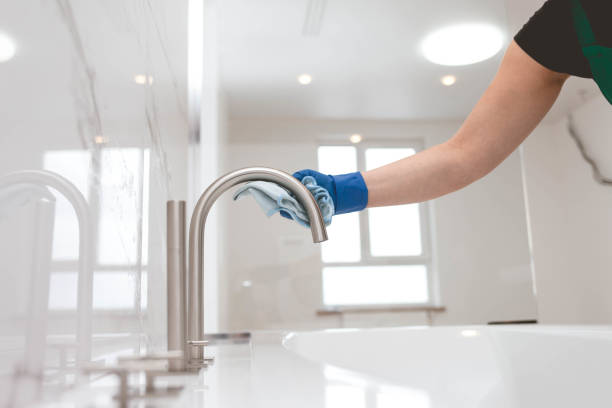A clean bathtub is one of life’s simple pleasures. It’s where we unwind, soak away stress, and sometimes even hide from the chaos of daily life. But let’s be real: cleaning it? Not exactly the most fun part of home care. Grime, soap scum, mildew, and mineral stains love to take up permanent residence in your tub.
Whether your bathtub is porcelain, fiberglass, acrylic, or enamel, this comprehensive guide will walk you through the best ways to clean it—step by step—with tried-and-true tips, tools, and natural alternatives. Best of all, we’re keeping it realistic, effective, and stress-free.

Why Regular Bathtub Cleaning Matters
Before diving into the how, let’s talk about the why.
- Hygiene: Bacteria, mold, and mildew thrive in moist environments.
- Stain Prevention: Regular maintenance prevents yellowing, soap scum, and mineral deposits.
- Longevity: Proper care helps preserve the tub’s finish, preventing costly repairs.
- Relaxation Factor: A sparkling tub is a more inviting tub. Simple as that.
Even if you’re not using your tub daily, regular cleaning helps maintain the space and keeps it fresh.
Bathtub Materials: Know Before You Clean
Different tubs need different approaches. Using the wrong cleaner can damage the finish.
1. Acrylic
- Lightweight, modern tubs.
- Avoid: Abrasive scrubbers or harsh chemicals.

2. Porcelain (Enamel-Coated Cast Iron or Steel)
- Durable but prone to chipping.
- Avoid: Acidic cleaners; can erode enamel over time.
3. Fiberglass
- Economical and common in older homes.
- Avoid: Abrasive scrubs; they can scratch the surface.
4. Cultured Marble
- Often found in prefab bath units.
- Avoid: Vinegar or bleach.
Always do a spot test if you’re unsure!
Essential Tools and Supplies
Here’s what you’ll need, depending on your cleaning method:
Basic Supplies:
- Soft sponges or microfiber cloths
- Baking soda
- White vinegar
- Dish soap
- Spray bottle
- Old toothbrush or small scrub brush
- Bucket
- Rubber gloves
- Squeegee or dry towel
For Deeper Cleans:
- Oxygen bleach (like OxiClean)
- Hydrogen peroxide
- Borax
- Magic Eraser
Optional (But Awesome):
- Drill scrub brush attachment
- Steam cleaner
Step-by-Step Bathtub Cleaning Routine (Weekly Maintenance)
This is your standard, go-to weekly bathtub clean. It takes 15–30 minutes and keeps things from getting scary.
Step 1: Rinse and Remove Debris
- Rinse the tub with warm water.
- Remove hair, leftover bath products, or any obvious grime.
Step 2: Apply Cleaning Solution
Choose your cleaner:
- DIY Natural Mix: 1 part white vinegar + 1 part dish soap in a spray bottle.
- Store-bought: Choose a non-abrasive bathroom cleaner suited to your tub type.
Spray liberally over the tub, especially targeting stained or scummy areas.
Step 3: Let It Sit
Let the cleaner soak in for 10–15 minutes. This breaks down buildup and makes scrubbing easier.
Step 4: Scrub the Surface
Use a non-abrasive sponge or cloth. For extra power, sprinkle baking soda on your sponge. Scrub in circular motions.
Step 5: Tackle the Corners & Fixtures
Use a toothbrush or small scrub brush to clean around:
- Faucet base
- Drain
- Overflow plate
- Caulk lines

Step 6: Rinse Thoroughly
Rinse with warm water to remove all cleaner residue. If possible, use a detachable shower head.
Step 7: Dry the Tub
Wipe down with a microfiber cloth or towel to prevent water spots and streaks.
Boom—clean tub.
How to Remove Tough Stains and Build-Up
1. Soap Scum
- Solution: Equal parts vinegar and dish soap.
- Method: Spray and let sit 15 minutes, then scrub.
- Alternative: Use a paste of baking soda and water.
2. Hard Water Stains
- Solution: Spray with vinegar and let sit 30 minutes.
- Scrub Gently: With a sponge or brush. Rinse thoroughly.
3. Mold or Mildew
- Solution: 1 part hydrogen peroxide + 2 parts water.
- Alternative: Oxygen bleach + water paste.
- Spray, let sit, scrub, and rinse.
4. Rust Stains
- Solution: Use a pumice stone (only on porcelain or enamel!) or a lemon + salt paste.
- Let sit 15 minutes before scrubbing.
5. Yellowing or Discoloration
- Solution: Borax + lemon juice or hydrogen peroxide paste.
- Apply, let sit, scrub, rinse.
Deep Cleaning: Monthly or Seasonal Routine
When your weekly clean doesn’t cut it, go deeper. This takes a bit more time but pays off.
1. Remove Everything
- Clear shampoo bottles, toys, mats, etc.
- Soak plastic bath items in a vinegar-water solution while you clean.
2. Tackle Grout and Caulk
- Use a grout brush and a paste of baking soda and peroxide.
- For mold, try a bleach pen or a vinegar soak.
3. Clean the Drain
- Pour in 1/2 cup baking soda, followed by 1/2 cup vinegar.
- Let fizz 10 minutes, then rinse with boiling water.
4. Shine Fixtures
- Use a cloth with vinegar or lemon juice to buff.
5. Finish with a Rinse and Dry
- Rinse all surfaces and buff with a dry towel.
Your tub will look (and smell) amazing.
Natural Bathtub Cleaner Recipes
1. Vinegar + Dish Soap Spray
- 1 cup white vinegar
- 1 cup dish soap
- Shake and spray
2. Baking Soda Scrub
- 1/2 cup baking soda
- Enough water to make a paste
- Optional: few drops of essential oil
3. Citrus Cleaner
- Fill a jar with lemon peels
- Cover with white vinegar
- Let sit 1–2 weeks
- Strain and use in a spray bottle
4. Heavy-Duty Paste
- 1/4 cup borax
- 1/4 cup hydrogen peroxide
- Mix and apply to tough stains
How to Keep Your Tub Cleaner, Longer
Cleaning’s great—but preventing buildup is even better. Try these tips:
- Rinse after each use. Prevents soap scum from setting in.
- Use a squeegee. Swipe down the walls and tub after each use.
- Leave the curtain or door open. Helps it dry out faster.
- Limit bath oils or tints. They leave residue.
- Install a drain hair catcher. Major game-changer.
- Deep clean monthly. Keeps grime from becoming permanent.
What to Avoid When Cleaning Your Bathtub
Avoid these common pitfalls:
- Abrasive tools: Steel wool, rough pads, etc. can scratch surfaces.
- Harsh chemicals: Drain cleaners, undiluted bleach, ammonia—they can damage finishes or create toxic fumes.
- Mixing chemicals: Never mix bleach and vinegar or ammonia—it creates toxic gases.
- Skipping the rinse: Always rinse thoroughly to remove cleaner residue.
FAQs About Bathtub Cleaning
How often should I clean my tub?
- Light maintenance weekly; deep clean monthly.
Can I use bleach?
- Sparingly and only if safe for your tub’s material. Never mix it with other products.
What’s the best tool for scrubbing?
- Non-abrasive sponge or microfiber cloth. Drill scrubbers work great for heavy-duty jobs.
How can I make my tub smell fresh?
- Use essential oils in your cleaner. Rinse with hot water. Keep it dry to avoid mildew.
Why does my tub still look dull after cleaning?
- Could be soap film buildup or hard water residue. Try vinegar-based cleaners or buff with a soft towel.
Final Thoughts: A Clean Tub, A Clear Mind
Cleaning your bathtub may not be the highlight of your week—but the payoff is huge. Not just in sparkle and shine, but in peace of mind. That little soak at the end of a stressful day? It feels so much better when you know the space is clean.
With this guide, you’ve got everything you need to clean smarter, not harder. So the next time you light a candle and slip into a warm bath, you can truly relax—because you’ve earned it.
